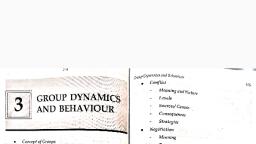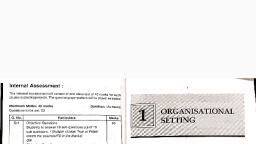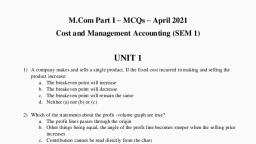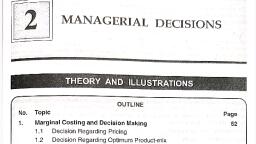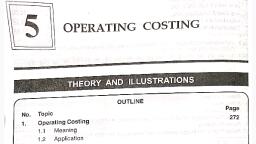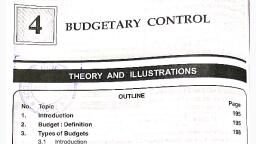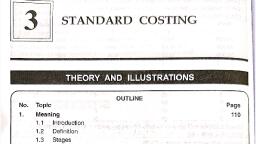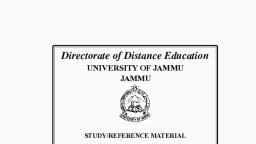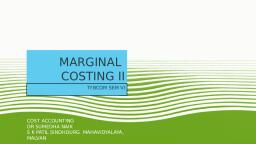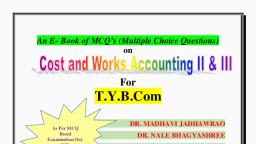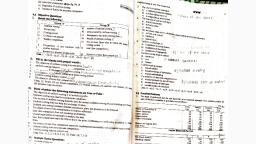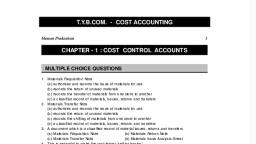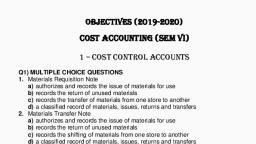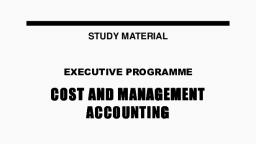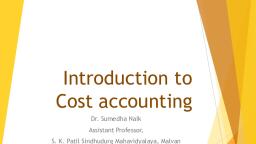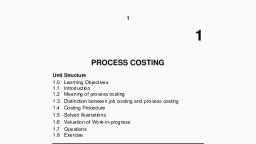Page 1 :
1 MARGINAL COSTING AND, ABSORPTION COSTING, , , , , , , , , , , , , , , , , , a muss y ure, , , , , , a OUTLINE *, No. Topic Page, 1. Methods V/s. Techniques of Costing 2, , 1.1 Methods of Costing, 1.2 Techniques of Costing, 2. Absorption Costing 2, 2.1 Meaning, 2.2 ~ Limitations, 3. Marginal Costing 3, 3.1 Introduction, 3.2 Definition, 3.3 Characteristics _ ‘, 4. Marginal Cost 4, 4:1 Definition :, 4.2 Marginal Unit (, 5. Determination of Marginal Cost 4, 5.1. Computation, 5.2 Procedure, 6. Marginal Cost Equations 6, 7. Contribution Analysis 6, 8. CVP Analysis / Profit-Volume Ratio e, 8.1 Profit Volume Ratio (PVR)°, 8.2 Use of CVP Analysis / PVR, 9. Break-even Analysis 8, 9.1. Break-even Point (BEP), 9.2 Margin of Safety (MOS), 9.3. Break-even Chart, 9.4. Assumptions and Limitations of Break-even Analysis, 9.5 — Limitations of Break-even Chart, XK : if ; y
Page 2 :
Cost and Management ACCOUNENR eee ee, , 4, , 3.3° CHARACTERISTICS :, ing. characteristics or aspects of Marginal Costing, The above definition brings out the follow: ast " :, (1) Marginal Costing is the ascertainment of Marginal Cost by differentiating between Fixed Costs, and Variable Cost., , (2) Marginal Costing is also the, , ascertainment of the effect on profit of changes in the volume and, , type of output. : /, Both these aspects - Determination of Marginal Cost and Ascertainment of Cost - Volume - Profit, Relationship - are discussed in detail in the following pages., , 4. MARGINAL COST, , PRM sauce, , Marginal Cost is the amount by, , the output is increased by one unit, t, = 10 per unit, the increase of output by one unit will 1, , Marginal Cost of producing the additional unit. Margina, , Overheads., , 4.2 MARGINAL UNIT, icle, a batch of articles, an order, a, , “One Unit’, in the above definition may indicate a single art, rtment and so on. This can also be called the Marginal Unit. ‘Change in Output’ may, utput by one unit may indicate , e output is changed by one unit. If, , he Variable Costs will increase. Thus if the Variable Costs are, ncrease the total costs by = 10. This is the, | Cost is equal to the Prime Cost + Variable, , which total costs change if th, , process, a depai, also indicate increase or decrease. Thus, change in o, , * increase or decrease of a single article,, * addition or discontinuance of one batch of articles,, , * accepting or not accepting a specific order,, * addition or discontinuance of a specific process,, , * addition or discontinuance of a department, and so on., Marginal Cost is the change in the cost in each of the above circumstances. It is the cost of the, Marginal Unit. It is the cost of doing or not doing a certain thing. Marginal Cost is thus the cost ofan, option. Clearly, therefore, Marginal Cost helps the management in ascertaining the cost of an option, , and taking decisions as to which option to accept or reject., , , , “5, DETERMINATION OF MARGINAL COST, , 5.1 * COMPUTATION, , Marginal Cost is equal to Variable Costs i.e. Prime Cost + Variable Overheads. Thus,, Marginal Cost = Prime Cost + Variable Overheads., Marginal Cost =, Prime Cost, , Direct Material Cost, , Direct Labour Cost, , Direct Expenses, + Variable Overheads, , Variable production overheads, , Variable Administration Overheads, , Variable Sales and Distribution Overheads.
Page 3 :
Marginal Costing and Absorption Costing 5, , Thus Marginal Cost excludes the Fixed Overheads, It excludes the Fixed Production Overheads +, Fixed Administration Overheads + Fixed Sales and Distribution Overheads. As far as Semi - Fixed, or semi - variable costs are concerned, they are separated into their fixed elements and variable, clements. The fixed clement is added to the Fixed Costs and the variable element is added to the, Variable Costs., , 5.2. PROCED!, , Marginal Cost of'a product is determined in the following manner , (1) Classification of Costs into Fixed and Variable Costs: The costs collected from different sources, , such as Material Records, Labour Records, Expense Vouchers are classified into Fixed Costs, and Variable Costs (discussed in detail in Para 12-18 below)., Fixed Costs are the costs which do not vary with change in volume. Fixed costs accrue in, relation to time e.g. rent accrues on per month basis. Fixed Costs, therefore are related to the, passage of time. For this reason, Fixed Costs are also known as Period Costs. Fixed Costs are, also known as Capacity Costs. Capacity Costs are the costs incurred to create the existing, production capacity of business. Thus, Fixed Costs will not change so long as the capacity remains, the same. Increase in capacity, however will require additional Fixed Costs. Examples of Fixed, Costs are Rent, Insurance, Property Taxes, executive Salaries etc., , Variable Costs are the costs that tend to vary in direct proportion to volume. Variable Costs, increase when the volume increases. On the contrary, Variable Costs decrease when the volume, decreases. Examples of Variable Costs are direct costs e.g. raw material, wages paid on piece, rate basis., , (2) Allocation of Marginal Cost to Product: Marginal Cost, as seen earlier, is = Prime Cost +, Variable Overheads. This Marginal Cost is allocated to the product (s). Thus the cost allocated to, each product is the Marginal Cost of that product. The Fixed Costs are not allocated, apportioned, or absorbed to the products. In fact there is no complicated process of apportionment, reapportionment or absorption of overheads in Marginal Costing. This is the main, difference between Absorption Costing and Marginal Costing., , (3) Valuation of Stocks at Marginal Cost: The closing stocks of each product are valued at its, Marginal Cost. Since the Marginal Cost excludes the Fixed Costs, the closing stocks are valued, , * only at the product costs. The period costs i.e. the Fixed Costs are not included in the closing, stock and hence not carried forward to the next year., , (4) Contribution: The difference between the Sale Value and the Marginal Cost is called Contribution., Thus, Contribution = Sales Value less Marginal Cost. Contribution is similar to the gross profit, ofa product. The Fixed Costs are deducted from the contribution to arrive at the net profits of the, concern. In case of a number of products, the contributions from all the products are added, together to determine the total contribution available for meeting the total Fixed Costs. If the, Contribution is less than the Fixed Costs, the concern is said to suffer a loss., , Illustration 1 :, Prepare Marginal cost Statement for product A, B and C from the following information , , , , , , , , , , , Particulars. » Hee) A B Cc, , e z v, Sales <d wadonwass 4,000 6,000 10,000, Variable Costs 3,600 4,800 6,000, Fixed Costs, (Absorbed on Sales Basis) Fewanconse Fase 600 900 1,500, Total Costs tists Saloas tah ela 4,200 5,700 7,500, Profit wena eel (-)200 300 2,500
Page 4 :
ieee (M. Com., adapted), Marginal Cost Statement For Product A, B & C, , , , Particulars A B Cc Total, e Ri = %, , , , Sales Value ajar Kata ae 4,000 6,000) 10,000] 20,000, Less : Marginal Costs oo ae 3,600 4,800 6,000} 14,400, , 400 1,200 4,000 5,600, , , , , , = Contribution, , , , Less : Fixed Costs tee toy spe eee eee 3,000, Profit aay! seepeaeay ase 2,600, , , , , , , , , , , , Note: The above example illustrates the utility of Marginal Costing over Absorption Costing for the, management. When the Fixed Costs are absorbed by the products, on an arbitrary basis, Product, A shows a loss. However, the Marginal Cost Statement clearly shows that Product A is earning, positive contribution or Gross Profit. If on the basis of Absorption Costing, product A had been, discontinued, its Contribution of ¥ 400 would not be available and the net profit of the concern would, have been reduced by % 400 from & 2,600 to ¥ 2,200., , 6. MARGINAL COST EQUATIONS —, , , , The following equations emerge from the Marginal Cost Statements discussed above , Sales - Variable Cost = Contribution [S - V = C] [1], Contribution - Fixed Costs = Profit [C - F= P] [2], Sales - Variable Cost = Fixed Costs + Profit [S- V= F+P] [3], , The last equation [S - V= F + P] is a very important equation widely used by management for taking, important decisions regarding production and sales., , If any three factors in the above equation are known the fourth factor can be worked out by solving, the equation., , Illustration 2 : ‘, , Thus, the Marginal Cost Equations in the Illustration No. 5.1 above, are as follows:, , Sales - Variable Cost = Contribution [S - V = C] [1], 20,000 - 14,400 = 5,600, , Contribution - Fixed Costs = Profit [C -F =P] [2], 5,600 - 3,000 = 2,600, , Sales - Variable Cost = Fixed Costs + Profit [S - V = F + P] [3], , 20,000 - 14,400 = 3,000 + 2,600, 7. CONTRIBUTION ANALYSIS. __, , Contribution is the most important concept in Marginal Costing. It is, as seen above, equal to Sales, Less Variable Cost. Contribution is the profit before adjusting the Fixed Costs. Marginal Costing is, concerned with the ‘product costs’ rather than the 'period costs’. Contribution indicates the, , Product Profit = Product Income - Product Cost i.e., Contribution = Sale Value - Variable Cost., , Marginal Costing assumes that the excess of sales value ove bution’ is, which will cover Fixed Costs as well as provide the concern’s profit. The amount of Contri ‘ Patt, credited to the Marginal Profit and Loss Account. The Fixed Costs are debited to sabes toe at, and Loss Account. If the Contribution is equal to the Fixed Costs, the concern 1s said to a ne, i.e. there is neither profit nor loss. If the Contribution is more than the Fixed Costs, there Wi ., Profit. If the Contribution is less than the Fixed Costs, there will be net loss. Thus the Fixed : 0: Ae, which are period costs do not affect the product cost. Fixed costs are directly adjusted in the Pro, and Loss Account prepared for the relevant period., , r Variable Costs contributes to a fund
Page 5 :
Marginal Costing and Absorption Costing 7, , The concept of Contribution plays a key role in assisting the management in taking many important, decisions such as , (1) deciding the break-even point,, , (2) deciding which article to produce, or continue or discontinue to produce,, , (3) deciding the quantity of each article to be produced or sold,, , (4) fixing the selling price, especially in a trade depression, or for a special order., The difference between contribution and accounting profit is explained below., , BSc, , , , , , , , , , No. | Contribution Profit, 1. | Itis a concept used in Marginal Costing.| It is an accounting Concept., 2. | It is before deducting Fixed Costs. It is after deducting Fixed Costs., 3. | At break-over point, Contribution is Profit arises only when Sales go, equal to fixed cost. beyond the break-even point., , , , 8. _ CVP ANALYSIS / PROFIT-VOLUME RATIO., , 8.1. .PROFIT- VOLUME RATIO (PVR), , Marginal costing, by its definition, means the ascertainment of the effect on profit of changes in, volume and type of output. Such ascertainment of the impact of changes in volume of output on, profit is done by means of the Profit - Volume Ratio. The Profit Volume Ratio or more appropriately,, the Contribution - Sales Ratio is defined as follows:, , , , Contributi c, Profit - Volume Ratio = es [pve = <| [4], , From this equation / ratio, the following equations / ratios can be derived:, Contribution = Sales x PV Ratio [C =S x PVR] [5], , Sales= “By Ratio PVR [6], , From the Marginal Cost Statement, it is clear that the Sales, the Variable Cost and Contribution vary, directly with the number of units. Thus, when the number of units (produced or sold) increases, the, Sales, the Variable Cost and the Contribution also increase pro-rata. On the contrary, when the, number of units goes down, the Sales, the Variable Cost and the Contribution are also lower. Thus,, there is a direct relationship between Volume, Variable Cost and Contribution. This is known as the, Cost - Volume - Profit Relationship. The analysis of this relationship is known as CVP analysis. The, Profit - Volume Ratio indicates this relationship., , Contribution E a c, , Illustration 3 :, The Profit-Volume Ratio of each product in the Illustration No. 5.1 above, is as follows , Contnibution [Pv = 4, , Profit-Volume Ratio = Sales Ss, , Product A = 400 / 4,000 = 1/10 = 10% of Sales, Product B = 1,200 / 6,000 = 1/5 = 20% of Sales, Product C = 4,000 / 10,000 = 4/10 = 40% of Sales, , The other Equations (5 and 6) can also be worked out as above for each product. Thus, if the, management wants to take a decision about increasing the sales of product A to % 5,000, it can, immediately ascertain that the Contribution due to increased Sales will be, , Contribution = Sales x PV Ratio = = 5,000 x 10% = = 500.


